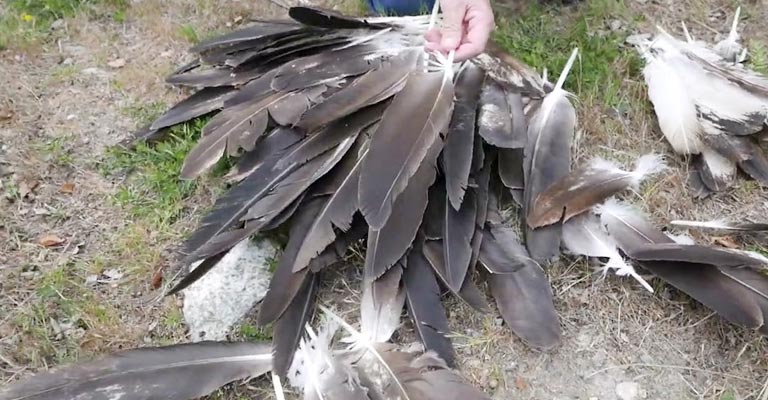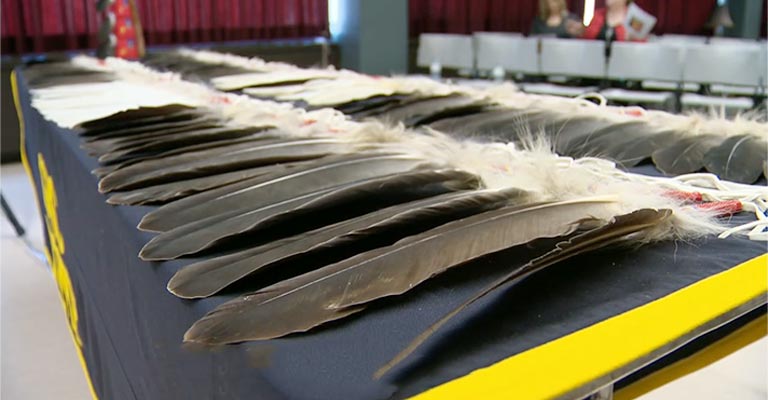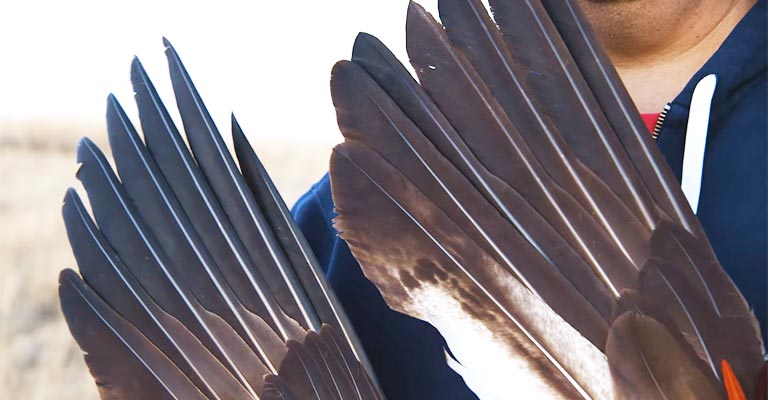The striking beauty and cultural significance of eagle feathers have long captivated humanity, but their possession and trade are subject to stringent legal restrictions in numerous countries.
The question of why are eagle feathers illegal delves into a complex interplay of ecological conservation, cultural heritage, and legal frameworks designed to protect these iconic birds.
These majestic raptors, particularly the Bald and Golden Eagles, hold revered positions in the natural world and various indigenous cultures.
In this exploration, we will unravel the multifaceted reasons behind the illegality of eagle feathers, from the imperative to conserve endangered species to the preservation of sacred traditions.
We will discover how these legal restrictions help maintain a delicate balance between the reverence for eagles and the need to safeguard their populations and habitats.

Why Are Eagle Feathers Illegal?
Eagle feathers are subject to legal restrictions and regulations due to several significant reasons, often stemming from the need to protect both the eagles and their cultural heritage.
Here are the key reasons why eagle feathers are illegal:
Conservation Concerns
Many eagle species were once threatened by habitat loss, hunting, and the pesticide DDT. Legal restrictions on eagle feathers aim to safeguard these birds and their populations.
The Bald and Golden Eagle Protection Act in the United States, for instance, has played a crucial role in the conservation of these iconic raptors.
Cultural and Religious Significance
Eagle feathers hold immense cultural and religious importance for many Indigenous peoples. Legal restrictions are in place to prevent the unauthorized possession or sale of these feathers, preserving the sanctity of these traditions.
Protection of Nesting Sites
Eagles are sensitive to disturbance, particularly during the nesting season. Legal regulations protect nesting sites and restrict activities that could disrupt eagles during this critical period, ensuring the survival of young eagles.
Preventing Poaching
Eagle feathers have been historically coveted for their beauty and rarity, leading to illegal poaching and black market trade. Legal restrictions help combat poaching and maintain the integrity of wildlife laws.
Scientific Research
Research involving eagles may necessitate access to feathers or other biological samples. Legal regulations allow scientists to conduct essential research while ensuring ethical and legal handling of these materials.
Raptor Rehabilitation
In cases of injured or orphaned eagles, rehabilitation centers may need to possess feathers or body parts for medical or educational purposes. Legal exceptions permit these facilities to care for eagles while adhering to regulatory guidelines.
Educational and Cultural Exemptions
Legal provisions may permit specific educational and cultural organizations to possess and use eagle feathers for educational, religious, and ceremonial purposes under controlled conditions and with proper permitting.
In summary, the illegality of eagle feathers serves multiple purposes, including eagle conservation, protection of cultural heritage, prevention of poaching, and the facilitation of ethical scientific research and raptor rehabilitation.
These regulations are essential for maintaining the balance between preserving a revered symbol and safeguarding the environment.
In Which Countries Are Eagle Feathers Illegal?

The possession, sale, and use of eagle feathers are regulated by various laws and regulations in several countries. Here are the countries where eagle feathers are subject to legal restrictions:
United States
Eagle feathers are strictly regulated in the United States under the Bald and Golden Eagle Protection Act and the Migratory Bird Treaty Act. Possession, sale, or trade of eagle feathers is illegal, with exceptions for Native American tribes who can obtain permits for religious and cultural use.
Canada
Canada also enforces strict laws regarding eagle feathers and other bird parts. They are protected under the Migratory Birds Convention Act. Permits are required for activities involving eagles, and unauthorized possession or trade is prohibited.
India
In India, eagles are protected under the Wildlife Protection Act. Possession and trade of eagle feathers are illegal, with stringent penalties for offenders.
Australia
Australia has stringent wildlife protection laws, and various eagle species are listed as protected wildlife. Possession and trading of their feathers are subject to legal restrictions under state and federal regulations.
United Kingdom
The UK has laws and regulations in place to protect various eagle species. The Wildlife and Countryside Act 1981 and the Protection of Birds Act 1954 restrict the possession and trade of eagle feathers.
Russia
Russia enforces laws aimed at protecting its eagle populations, which include the steppe eagle and golden eagle. These species are listed as vulnerable, and regulations exist to safeguard them from hunting and trade.
Nepal
Nepal is home to several eagle species, and they are protected under the National Parks and Wildlife Conservation Act. The hunting, possession, and trade of eagle feathers are illegal in the country to ensure their conservation.
These countries have enacted legal frameworks to protect eagles and their feathers, emphasizing the importance of preserving these magnificent birds and their ecosystems.
Violations of these regulations can result in severe penalties to deter illegal activities related to eagle feathers.
What Should I Do If I Find Eagle Feathers?

Finding eagle feathers can be a captivating experience, but it’s crucial to handle them responsibly, as many countries have strict laws regulating the possession and trade of these feathers.
Here are the necessary steps to follow if you come across eagle feathers:
Do Not Touch or Disturb
When you find eagle feathers, refrain from touching, picking up, or disturbing them. Leave them in their natural environment. Handling feathers can damage them and may be illegal in some places.
Observe and Appreciate
Take a moment to observe and appreciate the beauty of the feathers from a respectful distance. Enjoy this unique encounter without physically interacting with them.
Record Details
If you’re interested in birds or wildlife, note the location, date, and any distinguishing features of the feathers. This information can be valuable for research or documentation purposes.
Report to Authorities
If you believe the feathers are from an endangered or protected species, report your findings to local wildlife authorities or conservation organizations. They can determine whether the feathers should be collected for research or educational purposes.
Educational Use
If you’re an educator or involved in educational programs, consider contacting local wildlife or natural history organizations. They may be able to assist with educational displays or presentations featuring the feathers.
Cultural or Religious Significance
If you are a member of a Native American tribe or another group with cultural or religious significance attached to eagle feathers, consult with tribal or community leaders to ensure you handle the feathers appropriately and in accordance with relevant laws.
Leave No Trace
Regardless of the circumstances, always practice the Leave No Trace principles. Avoid disturbing the natural environment or habitat where you found the feathers, and be respectful of wildlife and their ecosystems.
Respecting wildlife and conservation laws is essential when encountering eagle feathers. Following these steps ensures that you enjoy the experience responsibly while contributing to the protection of these majestic birds and their habitat.
FAQs
Why are eagle feathers illegal?
Eagle feathers are illegal to protect these iconic raptors and conserve their populations. Various eagle species, like Bald and Golden Eagles, were once threatened by hunting, habitat loss, and the pesticide DDT.
Laws restricting eagle feathers help safeguard them from harm and contribute to their recovery.
What role does cultural significance play in the illegality of eagle feathers?
Cultural significance is a significant factor in the prohibition of eagle feathers. Many indigenous cultures hold eagles as sacred and consider their feathers central to spiritual and religious practices.
Legal restrictions respect these traditions and preserve the sanctity of these symbols.
How do legal frameworks protect the nesting sites of eagles?
Eagles are sensitive to disturbance, particularly during the nesting season. Legal regulations protect their nesting sites by prohibiting activities that could disrupt or harm eagles during this crucial period, ensuring the survival of young eagles.
What is the impact of legal restrictions on scientific research involving eagles?
Scientific research involving eagles may require access to feathers or biological samples. Legal restrictions aim to strike a balance between ethical research and legal handling of these materials, enabling scientists to study these birds without harming them.
Can eagle feathers ever be used legally?
Yes, there are exceptions and permits that allow for the legal use of eagle feathers in specific circumstances. These exceptions may include educational, research, or cultural purposes.
However, such use is strictly regulated to ensure the protection of these magnificent birds.
Conclusion
The question of why eagle feathers are illegal underscores the profound intersection of conservation, culture, and legal frameworks.
Legal restrictions aim to conserve these magnificent birds, protect their habitats, and honor the sacred traditions of indigenous cultures.
These regulations serve as a testament to the resilience of eagle populations and the recognition of their significance in both the natural world and the cultural heritage of communities.
Striking a delicate balance between reverence and preservation, the prohibition of eagle feathers is a compelling example of how humanity strives to harmonize its relationship with the natural world, recognizing the vital role of these remarkable birds in our collective conscience.